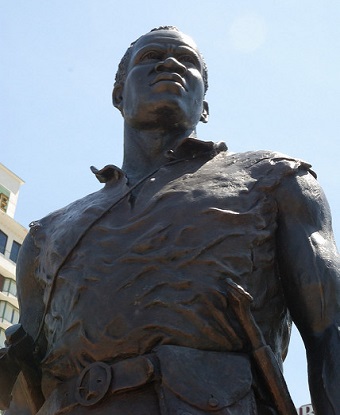Last updated: August 1, 2025
Person
York

Louisville Images
Little is known about the life of York. He was an enslaved man owned by William Clark, and later became a member of the Corps of Discovery. William Clark inherited York as property when the elder Clark died, and the two were around the same age. York was one of only two members of the original Corps who was married.
York is often mentioned in the journals kept by both Lewis and Clark throughout the course of the Expedition. These journal entries indicate that he experienced freedoms that few enslaved people had, though these freedoms would be revoked upon his return to the Clark plantation.
The journals indicate that York was allowed to hunt, which was notable because African Americans weren’t generally allowed to handle guns. He became the primary caregiver to Charles Floyd, who died during the Expedition from what is believed to have been appendicitis. He risked his life to save Clark, Sacagawea, and her son when they were caught in a flash flood. York is also credited with being the first African American to have a vote equal to that of a white man. In November 1805 the Corps held a vote to decide where to camp for the winter, and both York and Sacagawea cast votes on that location.
When the Corps of Discovery returned from the Expedition, each member - except York - received double pay and 320 acres of land. York, on the other hand, returned to slavery. Clark denied York’s initial requests for freedom, recording in 1808 that:
“I did wish to do well by him. But as he got Such a notion about freedom and his emence Services...I do not think with him, that his Services has been So great/or my Situation would promit me to liberate him.”
York was finally freed sometime after 1815. With his freedom, Clark gave York a wagon and team of horses, with which York created a hauling business. By 1832, however, Clark told author Washington Irving that York’s business failed, and that he had contracted cholera and died in Tennessee. The location of his burial is unknown.
Sources:
York - Lewis & Clark National Historic Trail (U.S. National Park Service) (nps.gov)
http://www.pbs.org/lewisandclark/inside/york.html
http://www.pbs.org/lewisandclark/living/idx_5.html
http://filsonhistorical.org/york-of-the-lewis-and-clark-expedition/